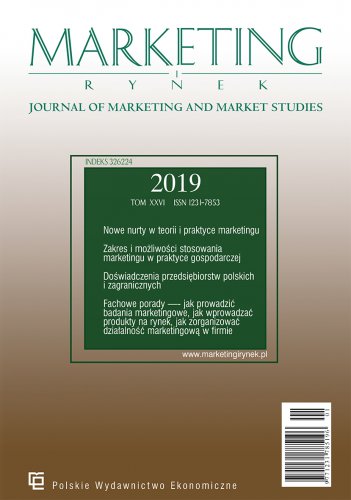Modern research methods in the field of customer experience
Customer experience studies are an important component of research portfolio of every significant research agency. The main goal of this article is to show the key areas for CX and types of research which conducted in the field. The article also features two latest tools examining customer experience developed by Kantar research agency: the qualitative tool based on gamification – „Our City” and the quantitative one called CX+. The underlying premises of both tools and the areas of applications with their unique contribution in the CX research process have been described as well.
References
Anderson, E.W. & Mittal, V. (2000). Strengthening the satisfaction profit chain. Journal of Service Research, 3(2), 107–120. https://doi.org/10.1177/109467050032001
Becker, S., Goldstein, D., & Sweeney, T. (2013). Does a gamified approach provide greater insight? ARF Experiential Learning, Re:Think conference.
Brakus, J. J., Schmitt, B. H., & Zarantonello, L. (2009). Brand Experiences: What Is It? How Is It Measured? Does It Affect Loyalty? Journal of Marketing, 73, 52–68. https://doi.org/10.1509/jmkg.73.3.052
Brakus, J. J., Schmitt, B. H., & Zhang, S. (2008). Experiential Attributes and Consumer Judgments. In B. H. Schmitt & Rogers, D. (Eds.), Handbook on Brand and Experience Management. Northampton: Edward Elgar. https://doi.org/10.4337/9781848446151.00022
Brown, R. (1988). Group processes: Dynamics within and between groups. Cambridge: Basil Blackwell.
Cetin, G. & Dincer, F.I. (2014). Influence of customer experience on loyalty and word-of-mouth in hospitality operations. Anatolia, 25(2), 181–194. https://doi.org/10.1080/13032917.2013.841094
Dziewanowska, K. (2015). Dimensions of real and virtual consumer experiences. UW Faculty of Management Working Paper Series, 9(4), 1–36.
Gentile, C., Spiller, N., & Noci, G., (2007). How to sustain the customer experience: An overview of experience components that cocreate value with the customer. European Management Journal, 25(5), 395–410. https://doi.org/10.1016/j.emj.2007.08.005
Harrison, P. (2011). The researchification of games: Adopting a game designer's approach to market research. ESOMAR Congress Miami.
Homburg, C., Schwemmle, M., & Kuehnl, C. (2015). New product design: Concept, measurement, and consequences. Journal of Marketing, 79(3), 41–56. https://doi.org/10.1509/jm.14.0199
Kahneman, D. (2010). The riddle of experiences versus memory. TEDtalk. Retrieved from https://www.ted.com/talks/daniel_kahneman_the_riddle_of_experience_vs_memory?language=nb https://doi.org/10.1037/e623702010-001
Kantar. (2018a). Insights2020 – UK Groceries Report.
Kantar. (2018b).US Retail Banking Report.
Kantar. (2019). The Experience Advantage. 2019 Report Retail Banking.
Keiningham, T. L., Cooil, B., Aksoy, L., Andreassen, T. W. & Weiner, J. (2007) The value of different customer satisfaction and loyalty metrics in predicting customer retention, recommendation and share-of-wallet. Managing Service Quality, 17(4), 361–384. https://doi.org/10.1108/09604520710760526
Kim, S., Cha, J., Knutson, B. J., & Beck, J. A. (2011). Development and testing of the Consumer Experience Index (CEI). Managing Service Quality, 2, 112–132. https://doi.org/10.1108/09604521111113429
Klaus, P. & Maklan, S. (2013). Towards a better measure of customer experience. International Journal of Market Research, 55(2), 227–246.
Kotler, P., Kartajaya, H., & Setiawan, I. (2016). Marketing 4.0: Moving from Traditional to Digital. Hoboken: John Wiley & Sons.
Lemon, K. N. & Verhoef, P. C. (2016). Understanding customer experience throughout the customer journey. Journal of Marketing, 80(6), 69–96. https://doi.org/10.1509/jm.15.0420
Meyer, C. & Schwager, A. (2007). Customer experience. Harvard Business Review, 85(2), 116–126.
Paharia, R. (2013). Loyalty 3.0: How to Revolutionize Customer and Employee Engagement with Big Data and Gamification. New York: McGraw-Hill. https://doi.org/10.1108/jcm-09-2013-0700
Puleston, J. & Rintoul, D. (2012). Can survey gaming techniques cross continents? Examining cross cultural reactions to creative questioning techniques. ESOMAR Congress Shanghai.
Puleston, J. & Sleep, D. (2011) The game experiments: Researching how game techniques can be used to improve the quality of feedback from online research. ESOMAR Congress Amsterdam.
Ścibor-Rylski, M. (2018). Gamification as an effective method in the modern market research. Marketing i Rynek, (10), 36–44.
Ścibor-Rylski, M. (2019). Gamification – the key to in-depth exploration of consumer behaviour in market research. Annales Universitatis Mariae Curie-Skłodowska, sectio H – Oeconomia, 53(1). https://doi.org/10.17951/h
Sharp, B. (2010). How brands grow. What marketers don’t know. South Melbourne: Oxford University Press. https://doi.org/10.1108/10610421211215715
Vasconcelos, A. M., Barichello, R., Lezana, A., Forcellini, A., Ferreira, M. G. G., & Miguel, P. A. C. (2015). Conceptualisation of the service experience by means of a literature review. Benchmarking: An International Journal, 22(7), 1301–1314. https://doi.org/10.1108/bij-08-2013-0078
Verhoef, P. C., Lemon, K. N., Parasuraman, A., Roggeveen, A., Tsiros, M., & Schlesinger, L. A. (2009). Customer experience creation: Determinants, dynamics and management strategies. Journal of Retailing, 85(1), 31–41. https://doi.org/10.1016/j.jretai.2008.11.001
Zarantonello, L. & Schmitt, B. H. (2010). Using the brand experience scale to profile consumers and predict consumer behaviour. Journal of Brand Management, 17(7), 532–540. https://doi.org/10.1057/bm.2010.4

